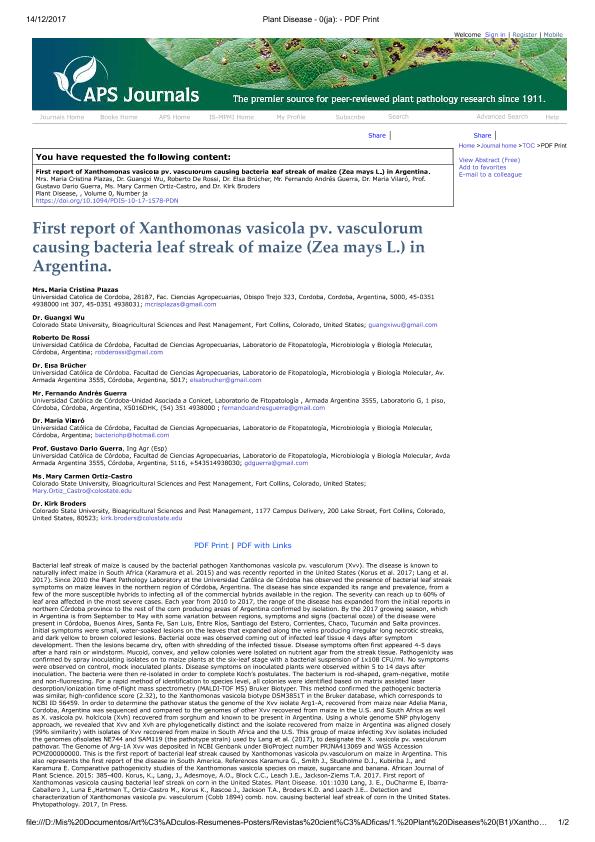Mostrar el registro sencillo del ítem
dc.contributor.author
Plazas, María Cristina
dc.contributor.author
de Rossi, Roberto Luis

dc.contributor.author
Brücher, Elsa

dc.contributor.author
Guerra, Fernando Andres

dc.contributor.author
Vilaro, Mario Lamas

dc.contributor.author
Guerra, Gustavo Dario

dc.contributor.author
Wu, G.
dc.contributor.author
Ortiz-Castro, M.C.
dc.contributor.author
Broders, K.
dc.date.available
2022-01-24T19:49:12Z
dc.date.issued
2018-05
dc.identifier.citation
Plazas, María Cristina; de Rossi, Roberto Luis; Brücher, Elsa; Guerra, Fernando Andres; Vilaro, Mario Lamas; et al.; First report of Xanthomonas vasicola pv. vasculorum causing bacteria leaf streak of maize (Zea mays) in Argentina; American Phytopathological Society; Plant Disease; 102; 5; 5-2018; 1-3
dc.identifier.issn
0191-2917
dc.identifier.uri
http://hdl.handle.net/11336/150564
dc.description.abstract
Bacterial leaf streak of maize (Zea mays L.) is caused by the bacterial pathogen Xanthomonas vasicola pv. vasculorum (Xvv). The disease is known to naturally infect maize in South Africa (Karamura et al. 2015) and was recently reported in the United States (Korus et al. 2017; Lang et al. 2017). Since 2010, the plant pathology laboratory at the Universidad Católica de Córdoba has observed the presence of bacterial leaf streak symptoms on maize leaves in the northern region of Córdoba, Argentina. The disease has since expanded its range and prevalence, from a few of the more susceptible hybrids to infecting all commercial hybrids available in the region. The severity can reach up to 60% of leaf area affected in the most severe cases. Each year from 2010 to 2017, the range of the disease expanded from the initial reports in northern Córdoba Province to the rest of the corn-producing areas of Argentina, confirmed by isolation. By the 2017 growing season, which in Argentina is from September to May with some variation between regions, symptoms and signs (bacterial ooze) of the disease were present in Córdoba, Buenos Aires, Santa Fe, San Luis, Entre Ríos, Santiago del Estero, Corrientes, Chaco, Tucumán, and Salta provinces. Initial symptoms were small, water-soaked lesions on the leaves that expanded along the veins producing irregular long necrotic streaks, and dark yellow to brown colored lesions. Bacterial ooze was observed coming out of infected leaf tissue 4 days after symptom development. Then the lesions became dry, often with shredding of the infected tissue. Disease symptoms often first appeared 4 to 5 days after a hard rain or windstorm. Mucoid, convex, and yellow colonies were isolated on nutrient agar from the streak tissue. Pathogenicity was confirmed by spray inoculating isolates on to maize plants at the six-leaf stage with a bacterial suspension of 1 × 108 CFU/ml. No symptoms were observed on control, mock inoculated plants. Disease symptoms on inoculated plants were observed within 5 to 14 days after inoculation. The bacteria were then reisolated to complete Koch?s postulates. The bacterium is rod-shaped, gram-negative, motile, and nonfluorescing. For a rapid method of identification to species level, all colonies were identified based on matrix assisted laser desorption/ionization time of-flight mass spectrometry (MALDI-TOF MS) Bruker Biotyper. This method confirmed the pathogenic bacteria was similar, high-confidence score (2.32), to the Xanthomonas vasicola biotype DSM3851T in the Bruker database, which corresponds to NCBI ID 56459. To determine the pathovar status, the genome of Xvv isolate Arg1-A, recovered from maize near Adelia Maria, Cordoba, Argentina, was sequenced and compared with the genomes of other Xvv recovered from maize in the U.S. and South Africa as well as X. vasicola pv. holcicola (Xvh) recovered from sorghum and known to be present in Argentina. Using a whole genome SNP phylogeny approach, we revealed that Xvv and Xvh are phylogenetically distinct and the isolate recovered from maize in Argentina was aligned closely (99% similarity) with isolates of Xvv recovered from maize in South Africa and the U.S. This group of maize infecting Xvv isolates included the genomes of isolates NE744 and SAM119 (the pathotype strain) used by Lang et al. (2017), to designate the Xvv pathovar. The genome of Arg-1A Xvv was deposited in GenBank under BioProject number PRJNA413069 and WGS accession PCMZ00000000. This is the first report of bacterial leaf streak caused by Xvv on maize in Argentina. This also represents the first report of the disease in South America.
dc.format
application/pdf
dc.language.iso
eng
dc.publisher
American Phytopathological Society

dc.rights
info:eu-repo/semantics/openAccess
dc.rights.uri
https://creativecommons.org/licenses/by-nc-sa/2.5/ar/
dc.subject
Xanthomonas vasicola pv vasculorum
dc.subject
Bacteria Leaf Streak
dc.subject
Zea mays
dc.subject
Argentina
dc.subject.classification
Agronomía, reproducción y protección de plantas

dc.subject.classification
Agricultura, Silvicultura y Pesca

dc.subject.classification
CIENCIAS AGRÍCOLAS

dc.title
First report of Xanthomonas vasicola pv. vasculorum causing bacteria leaf streak of maize (Zea mays) in Argentina
dc.type
info:eu-repo/semantics/article
dc.type
info:ar-repo/semantics/artículo
dc.type
info:eu-repo/semantics/publishedVersion
dc.date.updated
2022-01-06T15:02:34Z
dc.journal.volume
102
dc.journal.number
5
dc.journal.pagination
1-3
dc.journal.pais
Estados Unidos

dc.description.fil
Fil: Plazas, María Cristina. Universidad Catolica de Córdoba. Facultad de Cs.agropecuarias. Cátedra de Fitopatologia; Argentina
dc.description.fil
Fil: de Rossi, Roberto Luis. Universidad Catolica de Córdoba. Facultad de Cs.agropecuarias. Cátedra de Fitopatologia; Argentina
dc.description.fil
Fil: Brücher, Elsa. Universidad Catolica de Córdoba. Facultad de Cs.agropecuarias. Cátedra de Fitopatologia; Argentina. Consejo Nacional de Investigaciones Científicas y Técnicas; Argentina
dc.description.fil
Fil: Guerra, Fernando Andres. Consejo Nacional de Investigaciones Científicas y Técnicas; Argentina. Universidad Catolica de Córdoba. Facultad de Cs.agropecuarias. Cátedra de Fitopatologia; Argentina
dc.description.fil
Fil: Vilaro, Mario Lamas. Universidad Catolica de Córdoba. Facultad de Cs.agropecuarias. Cátedra de Fitopatologia; Argentina
dc.description.fil
Fil: Guerra, Gustavo Dario. Hospital Privado Centro Médico de Córdoba; Argentina
dc.description.fil
Fil: Wu, G.. State University of Colorado - Fort Collins; Estados Unidos. Universidad Catolica de Córdoba. Facultad de Cs.agropecuarias. Cátedra de Fitopatologia; Argentina
dc.description.fil
Fil: Ortiz-Castro, M.C.. State University of Colorado - Fort Collins; Estados Unidos
dc.description.fil
Fil: Broders, K.. State University of Colorado - Fort Collins; Estados Unidos
dc.journal.title
Plant Disease

dc.relation.alternativeid
info:eu-repo/semantics/altIdentifier/url/https://apsjournals.apsnet.org/doi/abs/10.1094/PDIS-10-17-1578-PDN
dc.relation.alternativeid
info:eu-repo/semantics/altIdentifier/doi/https://doi.org/10.1094/PDIS-10-17-1578-PDN
Archivos asociados
